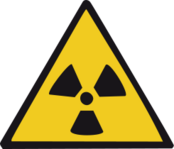Cobalt and cesium irradiators
From WikiLectures
Cobalt and cesium irradiators are among the irradiators used in radiotherapy and are a source of gamma radiation .
- are sources of so-called telecuria-therapy, ie irradiation with radioisotope sources from a distance
- An important parameter of radioisotope irradiators is the appropriate energy and physical half-life of radionuclides
- today, however, they are used mainly in palliative and non-cancerous radiotherapy, they are gradually being decommissioned
Cobalt irradiators[edit | edit source]
The radiation source is radioactive cobalt 60 Co (physical half-life is 5.29 years), which emits quantum gamma radiation with energies of 1.33 and 1.17 MeV with high penetration.
They are considered to be large irradiators (high source activity of at least 3,7,10 13 Bq) and are intended for deep radiotherapy.
Cesium irradiators[edit | edit source]
The radiation source is radioactive cesium 137 Cs (physical half-life is 30.4 years), which emits a quantity of radiation with an energy of 0.66 MeV. It is used to irradiate pathological deposits to a depth of max. 5 cm.
Irradiation device[edit | edit source]
The irradiation device is called a cobalt cannon .
- its essence is a strong lead protection box or spherical head (diameter up to 60 cm)
- the head contains a core of tungsten alloy or uranium (they have higher absorption than lead)
- the head transmits the primary gamma beam only in a narrow beam in the specified direction
Irradiation mechanism[edit | edit source]
- the source remains at rest, the primary beam of gamma radiation is released by a movable screen located under the outlet channel of the cover
- the source moves, rotates, or is pushed out of the center of the head above the output channel
Links[edit | edit source]
[edit | edit source]
Resources[edit | edit source]
- Šlampa, P .: Radiation Oncology. - textbook for students 5th year. LF MU Brno. < https://www.mou.cz/radiacni-onkologie-ucebni-text-pro-studenty-5-roc-lf-mu-brno/t2068 >
References[edit | edit source]
- NAVRÁTIL, Leoš and Jozef ROSINA, et al. Medical biophysics. 1st edition. Prague: Grada, 2005. pp. 383-384. ISBN 80-247-1152-4 .


